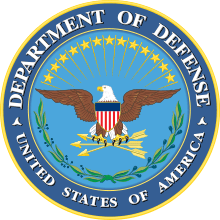Air Staff (United States)
|
| |
| Agency overview | |
|---|---|
| Formed | 1947 |
| Headquarters | Pentagon |
| Agency executive |
|
| Parent agency | Department of the Air Force |
The Air Staff is one of the Department of the Air Force's two statutorily designated headquarters staffs: the other staff is the Office of the Secretary of the Air Force, also known as the Secretariat. The Air Staff is headed by the Chief of Staff of the Air Force (currently General David Goldfein). The Air Staff is primarily composed of uniformed U.S. Air Force officials who assist the Chief of Staff in carrying out his dual-hatted role: as the principal military advisor to the Secretary of the Air Force, and as a member of the Joint Chiefs of Staff.
The Air Staff was reorganized in 2006 to be numbered in accordance with the Joint Staff system.[1] For the most part, the Joint Staff numbering system applies to the air staff. Of note, the Air Force separated Analysis and Assessments from A8 to create a separate directorate, A9, then in 2008, followed up with the creation of a separate directorate, A10, for the Air Force's nuclear mission.[2]
Joint Staff organization

For reference, the organization of the Joint Staff follows. See full article.
The Joint Chiefs of Staff organization includes the following departments where all the Joint Staff's planning, policies, intelligence, manpower, communications and logistics functions are translated into action.[3]
- DOM – Directorate of Management
- J1 – Personnel and Manpower
- J2 – Intelligence
- J3 – Operations
- J4 – Logistics
- J5 – Strategic Plans and Policy
- J6 – Command, Control, Communications and Computer Systems
- J7 – Operational Plans and Joint Force Development
- J8 – Force Structure, Resources, and Assessment
Constituents of the Air Staff
- Chief of Staff of the U.S. Air Force
- Vice Chief of Staff of the U.S. Air Force
- Assistant Vice Chief of Staff
- Chief Master Sergeant of the Air Force
- Deputy Chief of Staff for Personnel (A1)
- Deputy Chief of Staff for Intelligence, Surveillance and Reconnaissance (A2)
- Deputy Chief of Staff for Operations (A3)
- Deputy Chief of Staff for Installations, Logistics & Force Protection (A4)
- Deputy Chief of Staff for Strategic Plans & Requirements (A5/8)
- Chief, Information Dominance and Chief Information Officer (SAF/CIO A6)
- Director for Studies & Analyses, Assessments and Lessons Learned (A9)
- Deputy Chief of Staff for Strategic Deterrence and Nuclear Integration (A10)
- Chief of Security Forces
- Judge Advocate General
- Surgeon General
- Air Force Historian
- Chief of the Air Force Reserve
- Director of the Air National Guard
- Director of Tests and Evaluation
- Chief of Chaplain Services
- Chief of Safety
- Chief Scientist of the U.S. Air Force
Rapid Capabilities Office
The Air Force Rapid Capabilities Office, located in Washington, D.C., reports directly to a board of directors chaired by the Under Secretary of Defense for Acquisition, Technology, and Logistics. Board members also include the Secretary of the Air Force, the Chief of Staff of the Air Force, and the Assistant Secretary of the Air Force for Acquisition. The office responds to Combat Air Force and combatant command requirements.[4]
The RCO reports to a board of directors comprising the undersecretary of defense for acquisition, technology and logistics and the secretary and chief of staff of the Air Force. The office is staffed with a variety of functional specialists who form a collaborative melting pot of expertise. Inherent in the accomplishment of its mission to deliver capability is intent to experiment, within the bounds of statute, to discover and recommend new methods, processes, and techniques for the Air Force and the Department of Defense to conduct business in an efficient fashion.[4]
The Secretary of the Air Force activated the office 28 April 2003. One of its first projects was to deploy significant upgrades to the Integrated Air Defense System, now operational around the National Capital Region. Currently, RCO is working on the X-37B Orbital Test Vehicle to demonstrate a reliable, reusable, unmanned space test platform for the United States Air Force. Additionally, RCO, in conjunction with MIT Lincoln Lab and other partners, is developing a sensitive airborne receiver system. The system is scheduled for in-theater evaluation during the summer of 2009. The RCO Red Team assesses current and future threats to U.S. combat operations by providing independent technical assessments.[4]
See also
References
External links
- Organization of the U.S. Air force
- Countdown to A10 staff
- Air Force Staff Restructures to Improve Joint Ops, Communication


